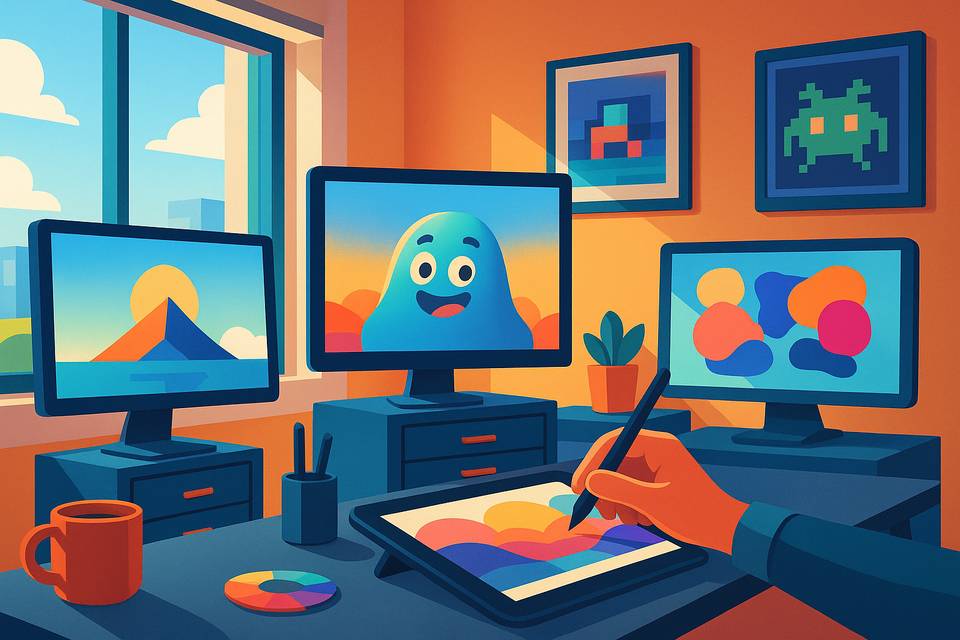Introduction
The digital art landscape has undergone significant transformations over the past few decades, with new styles and technologies emerging at a rapid pace. From pixel art and vector graphics to advanced AI-generated imagery, the evolution of digital art reflects cultural shifts and advancements in technology. In this blog post, we will explore the latest trends in digital art styles and how they are shaping the future of creative expression across various platforms.
The Rise of AI in Digital Art
One of the most notable transformations in recent years is the integration of artificial intelligence into the creative process. AI tools can generate stunning visuals in seconds, allowing artists to experiment and produce work that would have taken much longer traditionally. For instance, platforms like RestyleAI enable users to restyle images into different artistic formats—from Studio Ghibli to Pixar-style images—making creative expression accessible to everyone, regardless of their artistic skills.
Benefits of AI-Powered Digital Art Tools:
- Speed: Create complex images in minutes.
- Accessibility: No advanced skills required to produce high-quality art.
- Versatility: Transform images into various styles with just a click.
Trending Digital Art Styles
1. Minimalism
Minimalist design focuses on simplicity, using clean lines and limited color palettes. In digital art, this style promotes clarity and functionality, emphasizing the essential elements of a piece without distraction.
2. 3D Art
With the advent of more powerful graphic software and rendering techniques, 3D art has gained immense popularity. Artists use this style not only in illustrations but also in animations and interactive art forms, enhancing viewer engagement.
3. Mixed Media
Mixed media combines traditional and digital art techniques. This style allows artists to merge photographs, digital painting, and even physical materials, creating layered, dynamic compositions that convey deeper narratives.
4. Retro and Nostalgic Styles
The revival of retro styles, such as pixel art and 80s-inspired graphics, is prevalent among digital creators. Nostalgia-driven art connects audiences with their past, often evoking emotions tied to their experiences.
The Influence of Social Media on Digital Art
Platforms like Instagram and Pinterest have become essential for artists to showcase their work and reach wider audiences. This accessibility has led to new artistic trends and allowed for rapid sharing of ideas.
Key Points about Social Media's Impact:
- Exposure: Artists can instantly share their creations with a global audience.
- Networking: Social media facilitates connections between creators and art enthusiasts.
- Trend Propagation: New styles can become viral, quickening the evolution of art forms.
Emerging Trends to Watch
1. Augmented Reality (AR)
Augmented reality is transforming how audiences interact with digital art. Artists are increasingly integrating AR elements into their pieces, allowing viewers to experience art in new and immersive ways.
2. Interactive Installations
Digital art is becoming more participatory, with installations that invite audience interaction. This trend blurs the line between creator and viewer, fostering a collaborative artistic experience.
3. Generative Art
By employing algorithms to create visuals, generative art represents a new frontier in digital creativity. Artists can set parameters or themes, allowing machines to generate unique compositions that can surprise even the creators themselves.
The Future of Digital Art
As technology continues to advance, the digital art landscape is poised for even more innovation. From AI-generated content to evolving styles influenced by cultural shifts, the possibilities are virtually limitless.
Whether you’re an artist or simply an enthusiast, understanding these trends can inspire your own creative endeavors. Tools like RestyleAI provide opportunities for creators to experiment with various styles easily and effectively.
Conclusion
The evolution of digital art styles reflects a dynamic interplay between technology, culture, and individual expression. By harnessing new tools and trends, artists can explore their creativity and connect with audiences in unprecedented ways. As we look to the future, embracing these changes will be key to thriving in the ever-evolving digital art space.
Ready to elevate your digital art creations? Try RestyleAI for free and discover how easy it is to create mesmerizing visuals right from your own images today!
